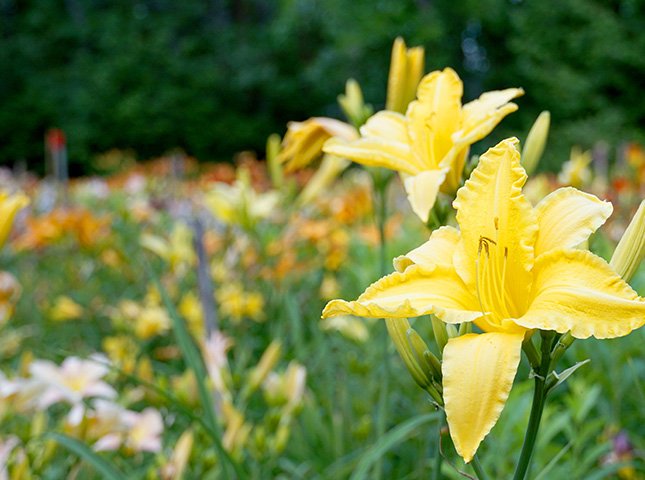Yes, deer eat daylilies and can cause significant damage to gardens. They’re particularly attracted to the plants during spring and early summer, consuming all parts including roots, flowers, buds, and leaves.
You’ll notice signs of deer browsing through ragged leaf edges, missing flowers, and sheared-off flower scapes. To protect your daylilies, consider implementing physical barriers like 8-foot tall fences, using natural or commercial repellents, and employing companion planting strategies with deer-resistant species.
While no truly deer-resistant daylily varieties exist, you can adapt your garden’s layout and protection methods based on seasonal deer activity. Understanding deer behavior and preferences will help you develop effective strategies for safeguarding your daylilies.
Table of Contents
Daylily Appetite of Deer
Deer have an insatiable appetite for daylilies, devouring every part of these colorful plants from root to bloom. You’ll find that these graceful herbivores don’t discriminate when it comes to daylily varieties, as no cultivar is truly resistant to their browsing habits.
Deer will destroy daylilies with remarkable efficiency, targeting not only the vibrant flowers but also the buds, leaves, and even the roots of newly planted seedlings. In your garden, you might notice that daylilies rank high on the deer’s menu, especially during spring when fresh growth emerges.
While the tough foliage might seem unappetizing to humans, it doesn’t deter these persistent foragers. The real draw for deer lies in the succulent buds and flowers, which they find irresistible. This preference can lead to significant damage in your daylily beds, particularly when other food sources are scarce.
It’s worth noting that the roots of daylilies also appeal to deer, posing an additional risk to your plants. Understanding this thorough appetite for daylilies can help you better protect your garden from deer-related destruction.
Signs of Deer Damage
You’ll quickly spot telltale signs of deer damage in your daylily garden if you know what to look for. Deer ate daylilies are often characterized by distinctive browsing patterns that can be easily identified.
As you inspect your garden, you’ll notice chewed leaves with ragged edges, missing flowers, and sheared-off flower scapes. These signs of Deer Damage are particularly evident in early spring when tender leaves and buds emerge, making newly planted daylilies especially vulnerable.
If deer are present in your area, you’ll observe unevenly trimmed foliage and a conspicuous absence of flower stalks. The damage isn’t limited to one part of the plant; deer consume all parts of daylilies, including buds, flowers, and leaves.
This thorough feeding can lead to significant damage throughout your garden. As the growing season progresses, you may find that entire plants have been stripped of their blooms and foliage.
Protecting Your Daylily Garden
Safeguarding your daylily garden from deer requires a multi-faceted approach combining physical barriers, repellents, and strategic planting techniques. One of the most effective protective measures is installing an 8-foot tall fence around your garden, which physically prevents deer from accessing your prized daylilies.
Additionally, you can interplant your daylilies with deer-resistant species, creating a less appealing environment for these voracious herbivores.
Commercial deer repellents, such as Bobbex, offer long-lasting protection for your daylilies. These formulas are safe for all parts of the plant and dry clear within hours, maintaining the aesthetic appeal of your garden. For a more natural approach, you can create homemade repellents using ingredients like eggs and garlic, which deter deer with their strong odors.
Regular maintenance of your garden is essential in minimizing deer visits. Apply mulch to retain moisture and remove fallen debris to reduce potential hiding spots for deer.
Continuously monitor deer activity in your area and be prepared to adjust your protection strategies accordingly. By employing a combination of these methods, you’ll greatly increase your chances of maintaining a thriving daylily garden free from deer damage.
Deer-Resistant Daylily Varieties
Despite popular misconceptions, there aren’t any truly deer-resistant daylily varieties. While daylilies are known for their tough foliage, they remain a favorite food source for deer, particularly during spring when new growth emerges. The attractive blooms and buds of these plants are especially vulnerable to browsing, posing a challenge for gardeners who wish to maintain their floral displays.
If you’re hoping to keep deer away from your daylilies, you’ll need to explore alternative strategies, as no specific cultivars offer natural resistance. Consider planting your daylilies in less accessible areas of your garden or implementing physical barriers to deter deer. Interplanting with other species known to be less palatable to deer may also help create a less inviting environment for these persistent grazers.
It’s important to recognize that daylilies rank among the top food choices for deer, making them susceptible to damage regardless of the variety you choose. While these resilient plants can often recover from browsing, consistent deer pressure can greatly impact their ability to bloom and thrive.
To protect your daylily garden, you’ll need to employ a combination of deterrent methods rather than relying on supposedly deer-resistant varieties.
Natural Deer Repellents
Natural deer repellents offer a chemical-free solution to protect your daylilies from hungry deer. By using ingredients like garlic, eggs, and hot pepper, you can create unpleasant odors that deter deer from browsing on your plants.
A homemade recipe includes blending 6 eggs, a whole head of garlic, and xanthan gum, which can be sprayed every five days for effectiveness. Adding peppermint oil can enhance the repellent’s deterrent properties when refreshed regularly.
While natural deer repellents can help reduce damage, they’re not foolproof and may require frequent reapplication, especially after rain or watering. To maximize protection for your daylilies, consider integrating these repellents with physical barriers or deer-resistant planting strategies.
Deer will eat daylilies if given the chance, but using natural repellents can discourage them. Here’s why you should consider using these eco-friendly solutions:
- They’re safe for your garden ecosystem
- You can easily make them at home
- They’re cost-effective compared to commercial products
- They don’t harm deer, just deter them
Remember that natural repellents provide temporary protection, so consistency in application is key to maintaining their effectiveness against deer browsing on your daylilies.
Fencing and Physical Barriers
A sturdy fence is your daylilies’ best defense against deer, providing a physical barrier that prevents these persistent browsers from reaching your prized plants. To effectively deter deer, consider installing fencing that stands 8 to 10 feet tall. This height is necessary due to deer’s impressive jumping abilities.
When selecting fencing materials, opt for folded 2 x 4-inch wire fencing, which not only prevents deer access but also reduces the risk of entanglement. If you’re concerned about aesthetics, black plastic deer fencing offers an attractive alternative that blends well with garden landscapes while still providing robust protection.
To maximize the effectiveness of your fencing strategy, consider planting your daylilies in less accessible areas of your garden where deer are less likely to venture. Additionally, growing vines on your fences can serve a dual purpose: enhancing the visual appeal of your garden while making the barrier appear more formidable to deer.
This combination of physical deterrence and strategic planting can considerably reduce the likelihood of deer browsing on your daylilies, ensuring your garden remains vibrant and undisturbed.
Companion Planting for Deterrence
Companion planting offers you a clever and eco-friendly way to protect your daylilies from deer while enhancing your garden’s overall beauty and diversity.
By strategically placing deer-resistant species like coneflowers and black-eyed Susans alongside your daylilies, you’ll create an environment that’s less appealing to these persistent grazers. Aromatic herbs such as rosemary and lavender can serve as natural deterrents, their strong scents often proving unappealing to deer.
Consider incorporating taller or denser plants as physical barriers around your daylilies. False cypress or tall junipers can effectively obstruct deer access to your prized blooms. Additionally, grouping daylilies with tough-foliaged plants like barberry or holly may discourage browsing by making the area seem less inviting.
This diverse planting approach not only protects your daylilies but also:
- Enhances your garden’s visual appeal
- Promotes biodiversity
- Supports local ecosystems
- Reduces reliance on chemical deterrents
Seasonal Strategies for Daylily Protection
Embracing seasonal strategies is essential for protecting your daylilies from deer throughout the year, as these persistent grazers’ feeding patterns and preferences shift with the changing seasons.
During spring and early summer, when daylily buds and flowers are most alluring to deer, you’ll need to intensify your protection efforts. Implement physical barriers like 8-foot tall fences to prevent deer from accessing your prized plants. You should also regularly apply deer repellents containing garlic or peppermint, reapplying frequently to maintain their effectiveness.
As the seasons progress, you’ll need to adapt your approach. Consider relocating your daylilies to less accessible areas of your garden and interplanting them with deer-resistant species. This strategy can help reduce the likelihood of deer damage year-round.
It’s vital to monitor deer activity and adjust your protection methods accordingly. Keep in mind that deer feeding patterns can vary based on available food sources and habitat changes.
Frequently Asked Questions
How Do I Keep Deer From Eating My Daylilies?
You can protect your daylilies from deer by installing tall fences, using Bobbex Deer Repellent, interplanting with deer-resistant species, applying homemade repellent sprays regularly, and placing daylilies in less accessible garden areas. These methods effectively deter deer browsing.
Which Daylilies Are Deer Resistant?
Unfortunately, there aren’t any truly deer-resistant daylilies. You’ll find that all varieties can attract deer, especially for their buds and flowers. If you’re determined to grow daylilies, you’ll need to use deterrent methods to protect them.
What Plant Do Deer Hate Most?
While deer dislike many plants, they particularly hate strongly scented ones like lavender and rosemary. You’ll find they also avoid thorny plants like holly and barberry. Fuzzy-leaved plants and bitter herbs are generally unappealing to deer as well.
What Flower Does a Deer Not Eat?
You’ll find deer avoid several flowers. They won’t eat toxic daffodils or foxgloves. They’ll also steer clear of aromatic lavender, sage, and marigolds. Coneflowers and black-eyed Susans are safe bets too, thanks to their tough texture.
Conclusion
You’ve learned that deer do indeed eat daylilies and can cause significant damage to your garden.
By implementing a combination of strategies, including physical barriers, repellents, and careful plant selection, you can protect your daylilies from these persistent herbivores.
Remember that no single method is foolproof, and you’ll need to adapt your approach seasonally.
With diligence and the right techniques, you can enjoy a thriving daylily garden while coexisting with local deer populations.


